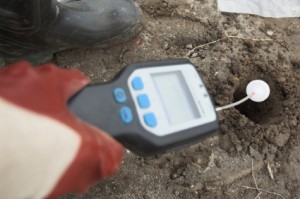
Ask Joel Salatin
Dear Joel,
What should I do with a yard that contains an “arsenic content” of 12.5? (Lack of recall on exactly what the measurement reflects other than the fac t that “over 5” is a level considered to require some possible remedy which has yet to be determined.)
t that “over 5” is a level considered to require some possible remedy which has yet to be determined.)
Thanks Joel!
-Kimie R.
Kimie-
Depends on what you’re doing with the yard—is it going to stay a yard, or are you going to turn it into an edible landscape? If it’s just going to stay a yard, the fastest way to remediate toxicity in the soil is with organic matter (OM). That’s the buffer. Back when Chernobyl blew and dropped radiation across the truck farming region of Austria, all the standing produce had to be destroyed. Then when they went and began measuring radiation in the soil, only one farm was able to resume production immediately: the Luebkes, who had been using copious amounts of compost instead of chemical fertilizer for many years. Their OM absorbed and dissipated the radiation. That’s just one of many stories, but OM is the key to everything.
The quickest way to get OM into your yard, if it’s going to stay a yard, is to just let the grass grow fairly tall (eight to ten inches) before cutting. That stimulates root growth because the plant maintains bilateral symmetry between what’s above the ground and what’s below the ground. By letting biomass accumulate above ground, you’re creating depth and volume in roots that the plant then prunes off when you eventually mow the top. Those pruned off roots add to OM. This, of course, is what we’re doing with tight controlled grazing, and how nature built soil for millennia under the hooves, pruning, and rest periods of grazing animals.
If you’re going to turn it into edible production, then I suggest you go with raised beds and put in clean soil, compost, and mineral. Vegetable roots don’t go very deep, so if you elevate off the current surface grade, say, twelve inches, you’ll be pretty safe in keeping the plant roots out of the arsenic zone. There are tons of ways to do this. One guy just gets some straw bales, puts them on their side, and then plants into the topside of the straw, adding a little compost and soil to give the plants something to start on. Go for it.
-Joel
[powerpress]Dear Joel,
For the last three years I’ve gotten late blight on my tomatoes. I have rotated the area I am growing them. I have changed to different seeds. Any help to avoid this problem would be appreciated.
Thanks!
-Chelia T.
Chelia-
This is pushing my pay grade on expertise. Generally, blossom end rot is a factor of inconsistent water, and that’s why it hits in late season. Mulching is a huge help to maintain consistent moisture levels. Of course, professionals use drip irrigation. But maintaining consistent moisture is huge for tomatoes.
I think—and I’m trying to remember things I’ve read—that magnesium deficiency can also encourage blight-type issues. You might try a good foliar like Neptune’s Harvest or even some Epsom salts to remediate that. One year we had white strips show up in our sweet corn, indicating magnesium deficiency. I mixed up some Epsom salts in the garden sprayer along with a surfactant and sprayed the corn. Within two hours the strips were gone, and it returned to a healthy green sheen. Foliars are amazing for quick remedial attention.
Beyond that, just keep working with the soil. Get books about tomatoes—ACRES USA has a great selection. Organic matter, proper mineralization, looseness, etc. are all going to be key. I’m not a tomato expert though—sorry.
-Joel
*Editor’s note: Solutions from Science also offers several books on growing tomatoes that may help with these issues. Best of luck!
 Off The Grid News Better Ideas For Off The Grid Living
Off The Grid News Better Ideas For Off The Grid Living

